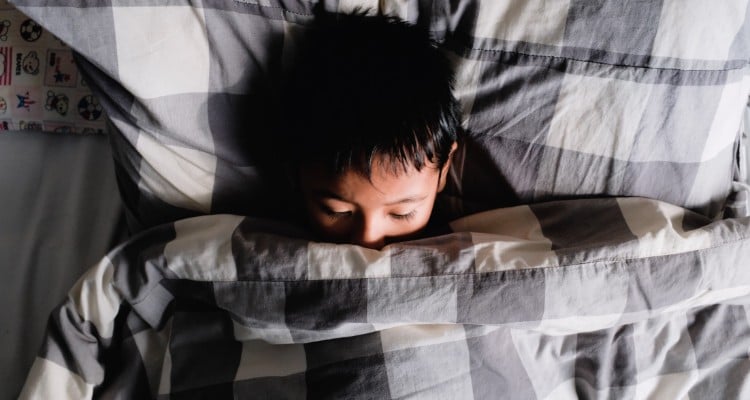-1.jpg?width=750&name=sleeping-child-boy-toddler-tired-home-sleepy-nap-couch-napping_t20_xvaQEX%20(1)-1.jpg)
By Ian D. Bier, ND, PhD, LAc, FABNO
Our neurological, psychological, and social development as children are all dependent upon positive sleep hygiene. However, as much as 30% of young children today are having trouble getting a full night’s rest.1
By studying the issue of sleep inconsistencies among today’s children, we have learned that a myriad of factors exists that prevents them from getting adequate sleep. These range from technological influences that didn’t exist decades ago to more psychological factors. Given what we know and what we are still learning, how can we help our kids get the sleep they need?
How is Modern Technology Affecting Our Kids’ Sleep Habits?
Technology has certainly evolved over the years. Between 2011 and 2014, the ownership of touch screen devices like tablets or smartphones have increased from 7% to 71%.2
Unfortunately, our increasing reliance on digital devices has created some negative impact on children’s sleeping habits. Studies have shown that artificial lighting exposure before bed can suppress the melatonin synthesis in the pituitary gland beneath the brain 3— the screens on tablets, cellphones, and TV’s fall under this same category of artificial lighting.
Unstable melatonin production can wreak havoc on our day and night cycles. It can even alter the brain pathways in young children, leading to less sleep and stunted neurological development. Therefore, parents must find balance by recognizing the need for “screen time” in modern culture while also acknowledging when it’s time to “power down.”
Furthermore, E-ink readers which have a stable pigment behind the reader’s glass instead of back-lit pixels can be an excellent alternative for parents interested in reading to their kids during bedtime.
 Room Temperature may be a Sleep Cycle Impediment
Room Temperature may be a Sleep Cycle Impediment
The second impediment to stable sleep cycles in children is room temperature. Historically, the sleep cycles of ancient human cultures were primarily determined by the setting and rising of the sun along with the changing atmospheric temperatures during dawn and dusk.
Even without the influence of modern technology, our sleep cycles still follow these same evolutionary patterns of pre-industrial societies. 4 As we have acclimated to modern, temperature-controlled houses, our internal physiology has lost the ability to engage in a natural shut-down sequence based on shifts in temperature.
Combine that with their constant consumption of artificial light, and it is no surprise that kids today are having difficulties establishing a consistent sleep routine.
Isolation Factors
Some children suffer from the fear of missing out, and this creates adversity during bedtime when they know that their parents and/or siblings are staying up late. In other cases, some children simply dislike isolation, and that’s what bedtime feels like to them.
It hasn’t always been a cultural norm to sleep alone; in fact it is a fairly recent development. Since human beings have not evolved to have our own private sleeping spaces, it feels unnatural for children during the development stages to spend hours alone in a dark room.
So if a child is having difficulty falling asleep alone, there are a few questions that parents can ask themselves: What can you do, as a parent, to help reduce their sense of isolation? Does this child have a sibling? Would it make sense to bunk them together in the same room?
Parents should also consider spending more time with their child before bed. Adding more time and devotion to a child’s bedtime routine, such as reading or playing soothing music, could mean all the difference in establishing a healthy sleep schedule.
The Power of Ritual
Often, a child refuses to go to sleep, calls their parents to their bedroom numerous times, or even refuses to stay in their bedroom because they don’t have this consistent bedtime routine.
If every night is different or if they don’t have a series of actions set in place indicating when it’s time to sleep, it can be difficult for a child to acknowledge that it’s time to start winding down mentally. A simple series of actions can be all that it takes to fix this issue. The child will recognize that bath time leads to storytime, which then leads to sleep time.
This form of ritual can be beneficial for the parent as well. Consider it a bonding practice as well as a form of meditation. It is an opportunity for both the parent and the child to wind down from the day and create a comforting sense of connection that eliminates the fear of isolation sometimes keeping children from staying in bed at night.
What to Do When Rituals Are Disrupted
It can take months for positive sleep habits to form. Even then, variations could crop up in the form of seasonal changes like the holidays, creating shifts in routines. Other factors that can either positively or negatively affect a child’s bedtime routine include what kind of day the child has had, what they have eaten, how they are feeling. Therefore, parents need to realize that making these changes can be challenging at times.
Every child is different. They each have individual needs that parents have to work with. The most powerful tool any parent has at their disposal is clear communication. In other words, they should explain to their child what is going on. They need to understand that they will feel better during the day and perform better in school if they go to bed earlier. Once you establish an open line of communication with the child, they often share what exactly is keeping them from going to bed in the first place.
Moreover, if there is going to be a significant disruption to a child’s sleep routine like a family trip, they need to know well in advance and how their sleeping arrangements are going to be different. Even if their bedtime might be a little later for some reason, but they should still try to get a good night’s sleep if they want to have fun the next day. These same principles apply if parents are having guests stay over.
When trying to improve bad sleeping habits in a young child, the most important steps involve establishing a routine and keeping communication open. It won’t always be easy, and parents may not see the exact results that they wanted quickly, but over time the habit will settle in. Through at it all, they can still take pride in any positive changes that occur. Maybe the children aren’t crying at bedtime anymore, or maybe they are staying in their bed. All of these are changes that still have a positive influence on a child’s development overall.

Sources:
1 “Daily Touchscreen Use in Infants and Toddlers is Associated with Reduced Sleep and Delayed Sleep Onset” 2017. https://www.nature.com/articles/srep46104#ref5. Accessed July 16, 2019.
2 “Children and Parents: Media Use and Attitudes Report” 2014. https://www.ofcom.org.uk/_data/assets/pdf_file/0027/76266/childrens_2014_report.pdf. Accessed July 16, 2019.
3 “Exposure to Room Light before Bedtime Suppresses Melatonin Onset… -JCEM” 2011. https://academic.oup.com/jcem/article/96/3/E463/2597236. Accessed July 16, 2019.
4 “Natural sleep and its seasonal variations in three pre-industrial societies” 2015. https://www.ncbi.nlm.nih.gov/pmc/articles/PMC4720388/. Accessed July 16, 2019.







-1.jpg?width=750&name=sleeping-child-boy-toddler-tired-home-sleepy-nap-couch-napping_t20_xvaQEX%20(1)-1.jpg)










